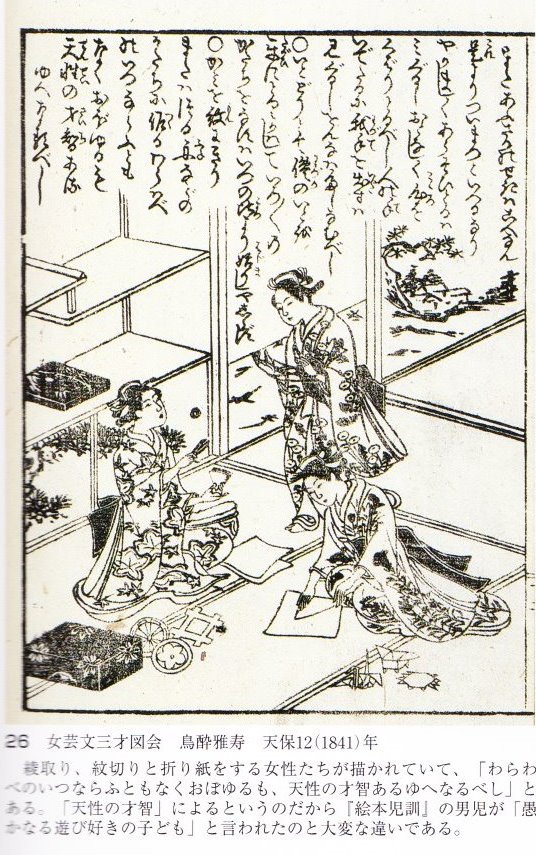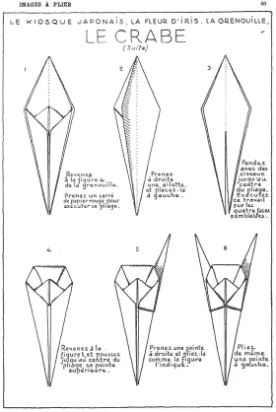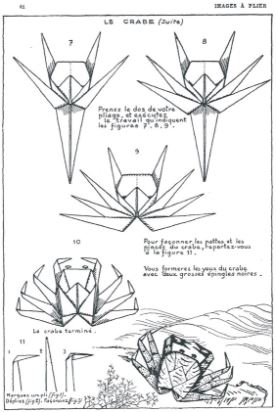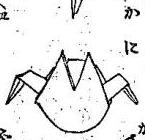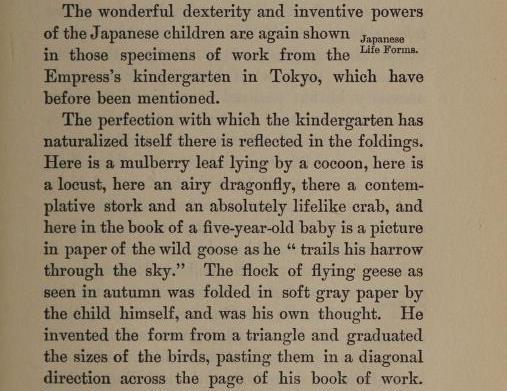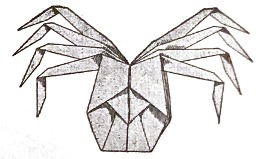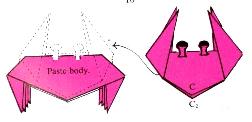| The Public Paperfolding History Project
Last updated 14/7/2025 x |
|||||||
| Folded Paper Crabs | |||||||
| This
page is being used to collect information about the
history of folded paper crabs. Please contact me if you
know any of this information is incorrect or if you have
any other information that should be added. Thank you. As far as I know all the early designs for folded paper crabs were made from squares using cuts. In the Kan no mado crab these slits are made along the vertical and horizontal bisectors of the square. In designs made from the frog base the slits are made along both diagonal bisectors. Later designs are sometimes made using different methods. Additional cuts are sometimes used to create eyes. Sometimes matchsticks are added to the design to serve as eyes instead. *********** 1841 This Japanese print from 1841 shows three women, or perhaps children at play. The figure at bottom right is folding paper. A completed Paper Crane and what appear to be a Sanbo on Legs and a Crab lie on the floor. Source: 'Oru Kokoro' - Catalogue of an exhibition on paperfolding history held in Tatsuno City History and Culture Museum in 1999.
********** The Kan No Mado Crab - 1845 onwards
********** The Cut Frog-Base Crab - 1878 onwards
********** 1889 Issue 852 of 'La Nature' of 28th September 1889 contained an article headed 'Recreation scientifiques' and subheaded 'La grenouille japonaise en papier'. Towards the end the article says, roughly translated, 'We also noticed in the exhibition other designs among which were the crab from red paper ...'. Unfortunately there is no way of telling whether this was The Kan No Mado Crab, The Cut Frog-Base Crab or some other design. ********** 1892 A design for another heavily cut crab appears in 'Kani Shukogaku' (Simple Handicraft) by Tamotsu Shibue, which was published in Tokyo in 1892. Note that this design was interpreted as a raccoon dog in 'Kindergarten Shoho'.
********** 1896 Part 2 of 'The Republic of Childhood', titled 'Froebel's Occupations', by Kate Douglas Wiggin and Nora Archibald Smith, which was published by Houghton, Mifflin and Company, of Boston and New York in 1896, contains reference to 'an absolutely lifelike crab' among specimens of work from the Empress's kindergarten in Tokyo. Unfortunately there is no way of telling whether this was The Kan No Mado Crab, The Cut Frog-Base Crab or some other design.
********** Another Cut Frog-Base Crab - 1900 onwards
********** 1939 A design for a cut crab folded from a frog base appears, as 'Cangrejo' in 'Plegado' by Rufino Yapur, which was published by Editores Independencia in Buenos Aires in 1939. It is not clear to me whether or not this is the same design as Another Cut Frog-Base Crab.
********** Honda's Compound Crab - 1958 onwards
********** 1965 Isao Honda's 'The World of Origami' which was published by Japan Publications Trading Company in the USA in 1965, included diagrams for making three different crabs: (from two partially separated squares with additional cuts to separate the legs)
********** (A version of) the Kan-no-mado Crab (from four partially separated squares)
********** Michio Uchiyama's Crab, made from a slit square with additional cuts to create the shape of the head / eyes
********** 1968 A 3-part compound cut crab appears in 'Origami in the Classroom: Book 2: Activities for winter through summer' by Chiyo Araki, which was published by Charles E Tuttle Co Inc in 1968.
********** |
|||||||
